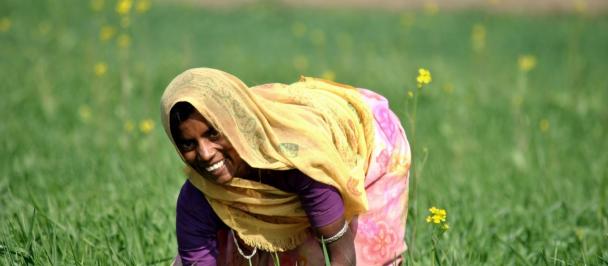By Julia Wolf, Food and Agriculture Organization; and
Our planet’s agricultural moonshot
November 29, 2018
We need to change the way we farm, the way we eat and the way we think if we as a civilization are going to survive the catastrophic impacts that climate change is already bringing to our people and to our planet.
A world above 2 degrees is nearly unthinkable. According to the new IPCC report, it will mean prolonged droughts in some parts of the world and greater risks from floods in others, dozens of large coastal cities will be flooded, budget makers and politicians will struggle to align priorities to pay for the projected US$54 trillion price tag, massive global migrations could take place as people flee the tropics, uncontrollable wildfires will wipe out communities and rangeland, women will be especially challenged by the dynamic impacts of climate change that affect women and girls differently than men, and more people could very well go hungry as the real threats to the food we eat and the way we farm are put to the test.
We need a moonshot moment. And agriculture needs to be at the heart of it.
As world leaders gather in Poland for this year’s climate talks, they need to place agriculture and planning at the forefront of these global efforts. On the nexus of farming, eating and planning, we can reduce significant amounts of greenhouse gases and we can protect the hundreds of millions of people whose lives and livelihoods are being uprooted by climate change.
How we farm
The start will be transformation on the farm. In Africa, agriculture accounts for 15 percent of overall CO2 emissions each year, while on a global level, agriculture, forestry and other land use account for 24 percent of all greenhouse gas emissions.
Several steps can be taken to transform agriculture across the globe and fuel our climate moonshot. This will not only help us feed our growing population – according to the Food and Agricultural Organization of the United Nations (FAO), we need to increase food production by 50 percent by 2050 to feed the estimated 9 billion people on our planet – but it will also significantly improve the lives of millions of people who are still hungry, still lack access to clean water, and still live on less than US$2 a day.
As part of the UN climate talks, world leaders will have the chance to contribute to the Koronivia Joint Work on Agriculture. Some key recommendations to improve efficiencies on the farm include:
- Improve planning processes to integrate agriculture into climate change adaptation plans
- Scale up technology transfer and improve South-South exchange of knowledge and practices
- Introduce efficient technologies and techniques
- Build capacity on the ground to support greener (and cleaner) farming
- Transform to more intensive farming, with more food produced in a smaller area
- Green value chains
- Engage with the private sector from small and micro-enterprise farmers to wholesale distributors
- Take gender-responsive approaches to climate actions

What we eat
One of the simplest solutions is to look more closely at consumption patterns and the sustainable production of food.
According to FAO’s Future of Food and Agriculture: “Agricultural production is expected to rise worldwide in response to population growth, dietary changes and increased incomes. Raising consumer awareness about environmentally sustainable and healthier diets, reducing food waste, pricing food to reflect the negative externalities of its production, and limiting the use of grains for biofuel production will all be critical to curb the demand for agricultural products. These actions will also be critical to reduce the “triple burden” of malnutrition that is, undernourishment, micronutrient deficiencies, and overweight and obesity, that often exist within a single country or even community.”
There are ways for policy makers and consumers alike to affect change in the way we eat.
- Connect farming with ecosystem-based adaptation, looking not just at life on the farm, but the connected tissues that interlink people with plow and forests with food
- Change farmer and consumer incentives to improve the production and demand for high-protein, low-emission foods
How we plan
A cornerstone of the United Nation’s mission to support nations in reaching the bold goals outlined in the Paris Agreement and 2030 Agenda for Sustainable Development is supporting improved planning processes.
This work is happening through joint programmes like the UNDP-FAO Integrating Agriculture in National Adaptation Plans Programme (NAP-Ag), the UNDP-UN Environment National Adaptation Plans Global Support Programme (NAP-GSP), and large country driven initiatives funded through vertical funds, multilateral and bilateral donors to mainstream and accelerate climate actions across the globe.
As we move toward the Poland climate talks and continue support for countries in transforming their agricultural sectors, some lessons learned ring true.
- Promote gender-sensitive approaches. Women will be key drivers in climate actions and transformation on the farm and at the table
- Improve monitoring and evaluation to take up lessons learned as we improve climate actions
- Build capacity on the national and local levels to make better decisions on climate change adaptation action
- Connect people with the ideas, innovative thinking and new ways of doing things
Links
FAO – The Koronivia joint work on agriculture and the convention bodies: an overview
Videos
The period from now until 2020 is critical to the success of the Paris Agreement. For UNDP, UN partners and the wider international community, the mission is clear: to push for countries, communities and the private sector to scale up ambition. By 2020, we want to see accelerated action on the climate targets — the Nationally Determined Contributions (NDCs) — of the Paris Agreement. Read more on: Climate 2020 — All In

 Locations
Locations



